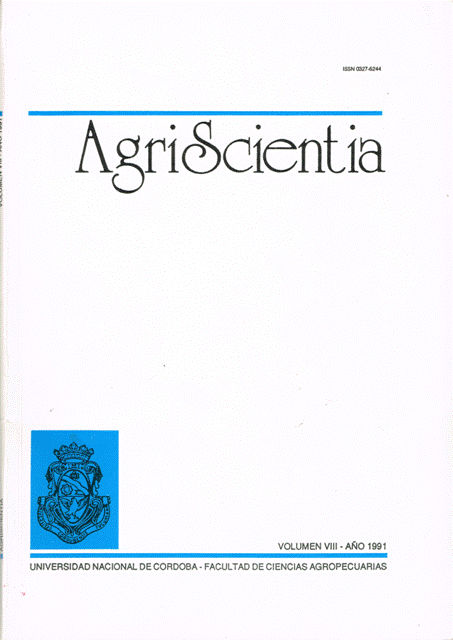Evaluation of different methods of synchronization of estrus in sheep
Main Article Content
Abstract
In order to study the comparative effect of three techniques of oestrus synchronization and lambing concentration, 100 Corriedale ewes were randomly allotted to 4 groups of 25 ewes each, which were identified as follows: group C, trial group; group F, ewes exposed to a ram fitted with a harness, hence incapable of servicing; group T, ewes exposed to a ram fitted with a harness and treated with 2 doses of testosterone injected 5 days apart; and group P, ewes exposed to a ram fitted with a harness and treated with 2 doses of PG F2α. There was no contact among the groups for 15 days prior to the service. Later, the 4 groups were put together and the ewes were exposed to 10 rams for 60 days. The Kruskal-Wallis test was used to determine the effect of the treatment on early parturitions. Multiple comparison analyses were later made. A statistical analysis with contingency tables and a χ² test at 95% confidence level was used to determine differences in lambing concentration.
Article Details

This work is licensed under a Creative Commons Attribution-ShareAlike 4.0 International License.
How to Cite
References
Barioglio, C. (1982). Uso de PGF2α como método para sincronizar celo y concentrar pariciones en ovejas Merino Precoz [Tesis de licenciatura, Universidad de Chile].
Barioglio, C., Varela, L., Ventura, J., Matar, P., & Rodríguez, T. (1989). Uso del carnero con amas y testosterona para concentrar pariciones en ovinos. Archivos de Zootecnia, 38(141), 167-175.
Boland, M., & Gordon, I. (1978). The effect of treatment by analogue (ICI 80 996) or progestagen (SC 9880) on ovulation and fertilization in cyclic ewes. Journal of Agricultural Science, 91, 727-730.
Carlson, J., & Barcikowski, B. (1973). PGF2α and the release of LH in sheep. Journal of Reproduction and Fertility, 34, 357-361.
Cupps, P., & Anderson, G. (1976). Estrous synchronization of heifers with PGF2α. Journal of Animal Science, 43, 280-281.
Douglas, R., & Ginther, O. (1973). Luteolysis following a single injection of PGF2α in sheep. Journal of Animal Science, 37, 990-993.
Evans, C. (1977). The role and regulation of PG in late pregnancy and parturition in sheep. M.R.C. Groups in Reproductive Biology, University of Ontario, Canadá.
García, G. (1970). Efecto de la suplementación invernal y sincronización del estro sobre la producción de corderos y lana. En XXI Jornadas Agronómicas. Chile.
Goding, J. (1974). The demonstration that PGF2α is the uterine luteolysin in ewes. Journal of Reproduction and Fertility, 38, 261-271.
Gordon, I. (1983). Controlled breeding in farm animals. Pergamon Press, N.Y.
Hearnshaw, H., & Restall, B. (1973). Observations on the luteolytic effects of PGF2α during the oestrus cycle and early pregnancy in the ewe. Journal of Reproduction and Fertility, 32(2), 322-323.
Inskeep, E. (1973). Potential uses of PG in control of reproductive cycles of domestic animals. Journal of Animal Science, 36(6), 1140-1155.
Kirton, K. (1972). The role of PG in reproductive physiology. Sciences, 2(2), 10-13.
Knight, T. (1983). Ram induced stimulation of ovarian and oestrous activity in anoestrus ewes: A review. Proceedings of the New Zealand Society of Animal Production, 43(7).
Thimonier, J. (1981). Practical uses of PG in sheep and goats. Acta Veterinaria Scandinavica, Supplementum, 77, 103-203.
Whitten, W. K. (1971). Pheromones and mammalian reproduction. National Biological Standards Laboratory, Canberra, Australia, 1-119.





